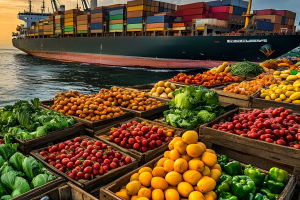Carbon on Plates
When we think about reducing our environmental impact, we often focus on things like transportation or electricity use. But have you ever considered the environmental cost of what's on your plate?
The term carbon footprint refers to the total amount of greenhouse gases (like carbon dioxide and methane) released into the atmosphere as a result of human activities.
And yes—this includes the production, processing, packaging, and transportation of food.
According to the Intergovernmental Panel on Climate Change (IPCC), food systems are responsible for approximately 21–37% of global greenhouse gas emissions. That means the way we grow, eat, and dispose of food has a massive impact on the environment—and the good news is, we have the power to make meaningful changes every day, starting with our meals.
From Farm to Fork: Where Emissions Come From
The carbon footprint of a single meal can vary greatly depending on the ingredients. Producing animal-based foods, especially red meat and dairy, generates significantly more emissions than plant-based foods.
This is due to multiple factors: livestock digestion releases methane, raising animals requires large amounts of feed and water, and clearing land for grazing leads to deforestation.
Even plant-based foods have emissions tied to them—from fertilizer use and irrigation to transportation and packaging. However, their overall impact tends to be lower, especially if they are locally grown and in season.
Here's a quick breakdown of major sources of emissions in food production:
• Agriculture (including fertilizer, water, and livestock): largest contributor
• Land use changes (like deforestation): high impact for meat and soy
• Transportation: especially for air-freighted items like berries or asparagus
• Packaging and processing: particularly for processed or frozen foods
• Waste: food thrown away produces methane in landfills
Which Foods Have the Highest Carbon Footprint?
Understanding which foods have the largest carbon footprints can help you make smarter choices. According to data from the Environmental Working Group (EWG) and Our World in Data, here are a few examples:
• Meat: Produces about 60 kg CO₂-equivalent per kilogram of meat
• Cheese: About 21 kg CO₂e per kilogram
• Lamb: Roughly 24 kg CO₂e per kilogram
• Poultry: Around 6 kg CO₂e per kilogram
• Tofu: Only 2–3 kg CO₂e per kilogram
• Lentils: Less than 1 kg CO₂e per kilogram
• Root vegetables and grains: Among the lowest emitters
In short, shifting even one or two meals a week away from red meat and toward legumes or grains can significantly reduce your personal carbon footprint.
Food Waste: The Hidden Emissions
It's easy to overlook, but food waste is one of the biggest contributors to food-related emissions. According to the United Nations Environment Programme (UNEP), nearly one-third of all food produced is never eaten.
When food rots in landfills, it releases methane—a greenhouse gas that is 25 times more potent than carbon dioxide over a 100-year period.
Reducing food waste not only saves money but also directly lowers your environmental impact. Simple steps like meal planning, proper food storage, freezing leftovers, and using "imperfect" produce can all help reduce unnecessary waste.
Local and Seasonal: Why It Matters
Eating locally and seasonally grown food reduces the need for long-distance transportation and artificial preservation. Food that travels shorter distances uses less fuel and typically requires less packaging. Additionally, seasonal foods are often fresher, tastier, and more affordable.
However, it's important to note that transportation typically accounts for a smaller portion of food's total emissions than production. That said, flying food by air creates much higher emissions than shipping or trucking, so avoid air-freighted produce when possible.
How Cooking Methods Affect Emissions
Even how you cook your food can affect your footprint. Using energy-efficient appliances, such as pressure cookers or induction stoves, helps reduce electricity or gas usage. Avoiding unnecessary preheating, batch-cooking meals, and using lids to cook faster can all help lower your kitchen's energy consumption.
According to the U.S. Department of Energy, using a microwave or pressure cooker instead of a conventional oven can reduce energy use by up to 80% for certain meals.
Making More Sustainable Choices
Reducing your plate's carbon footprint doesn't mean giving up all your favorite foods. It's about finding balance and making intentional swaps. Here are a few simple changes with big impact:
• Try Meatless Mondays: Replacing just one meat-based meal per week with a vegetarian one reduces annual emissions significantly.
• Favor whole foods: Unprocessed fruits, grains, and legumes use fewer resources than processed alternatives.
• Buy in bulk: Reduces packaging waste and transportation energy.
• Choose organic when possible: Organic farming often uses fewer synthetic fertilizers and may support healthier soil, though it's not always lower in emissions.
• Support local farmers: Farmers' markets and community-supported agriculture (CSA) programs reduce transportation emissions and support the local economy.
Carbon Labels and Tools
Some food brands and grocery stores are now beginning to add carbon footprint labels to their products, helping consumers make informed decisions. While not yet widespread, this trend is gaining momentum as people become more environmentally conscious.
There are also online tools and calculators that allow you to estimate the carbon footprint of your meals. Tools from WWF, BBC, or Carbon Trust let you input ingredients to get a snapshot of your meal's impact.
Health and Environment: A Win-Win
Interestingly, foods with a low carbon footprint often align with health-focused eating patterns. Diets rich in whole grains, legumes, fruits, and vegetables support both personal health and the health of the planet. A study published in The Lancet in 2019 introduced the concept of the Planetary Health Diet, which aims to meet nutritional needs while staying within environmental limits.
This reinforces the idea that by making small changes—such as eating more plant-based meals, cutting back on highly processed items, and avoiding waste—we're not just helping the Earth, but also improving our own well-being.
Your Plate, Your Power
The food choices we make every day are more powerful than most people realize. While climate change may seem like a problem too big for individuals to solve, our daily habits do matter. What we put on our plate adds up—across billions of people, every meal can be part of the solution.
-
 Japanese Meal GuideDiscover How We Make Authentic Japanese Cuisine at Home Step by Step—Delicious, Seasonal, and Easy!
Japanese Meal GuideDiscover How We Make Authentic Japanese Cuisine at Home Step by Step—Delicious, Seasonal, and Easy! -
 Crispy CubesTurn Simple White Bread into Golden, Crunchy Croutons in Minutes—Your Salads and Soups Will Thank You!
Crispy CubesTurn Simple White Bread into Golden, Crunchy Croutons in Minutes—Your Salads and Soups Will Thank You! -
 Local or Imported?Local vs. Imported Food: Which One Is Truly More Sustainable for Our Planet and Our Plates?
Local or Imported?Local vs. Imported Food: Which One Is Truly More Sustainable for Our Planet and Our Plates?
Copyright © zogu 2021 - 2025. All Right Reserved.